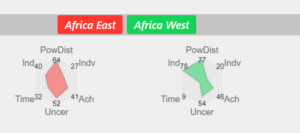Overview
An important, elderly African male Chief is testifying in a court of law regarding crimes against humanity. There is a female attorney examining him, however, the Chief, coming from a high power culture, cannot just be addressed directly by a younger female, and certainly not a female who stands over him, while he sits. Even just by standing up, when he is sitting is a cultural violation. Standing up is considered already disrespectful, especially if it is a woman who is not just talking, but putting questions to the Chief.
The questions that are being asked, are for the purpose of direct examination. The function of direct examination is for this Chief to illustrate to the panel of judges what he witnessed and experienced. However, upon being asked the first question, the Chief does not respond. By his gestures, he refuses to make eye contact with the lawyer, but instead looks down and avoids all eye contact.
The female lawyer observes and understands the issue at hand. She comes from the same geographical African region, where some of the cultural patterns are recognisable. As an action, she addressed the chamber to give the order to the Chief to answer her questions. The chamber explains the role of the attorney, saying she is representing the office of the prosecutor. Only after the Judges have explained clearly to the Chief, then he responds to the attorney’s line of questioning.
Behind the scenes in an interpreter booth, inside this booth there is several interpreters interpreting all interactions from the judges to the lawyers and the Chief. The role of the interpreter is to faithfully and accurately interpret all dialogue without bias.
The interpreter also observes the same situation, given he also is from the same region as the Chief, and geographical African region as the lawyer, however cannot explain this to the judges because it is not his role in the court proceedings in general.
Best practice: (In the ideal) So based on the interpreters understanding, the solution would be to have the prosecutors change and the Chief express himself with no barriers or limitations. In this process, they did not change the prosecutor because the Judge explained the role of the prosecutors. The same is also valid for a male interpreters who are requested to interpret for a female patient seeing a female doctor. The best practice would be have a female interpreter. This observation cannot be expressed by the interpreter, however it would be in all parties best interest to understand the dynamic to create the safest and most appropriate result that allows for complete understanding of the situation, with no barriers whatsoever.
Hofstede Dimensions
https://tcps.institute/cultural_bridges_tool.html

Outcome
Power Distance: The Chief finds the appointment of the young female lawyer offensive. A man of his social and political statue in his own country would never be confronted with such direct questions from a woman who stands while he sits. Masculinity: The Chief would perceive the role of the female lawyer as socially inappropriate and outside the social consensus. Given the sensitive nature of the Court, and the accurate social awareness that is exercises within the Court, it would be in the best interest that the prosecution team change attorney to a older male which balances the power distance of the Chief. An older, age appropriate male lawyer substitutes his female colleague, and the direct examination would resumes with the Chief fully participating.
Key language
African Chief , Attorney, Interpretation, Translation, Legal, Judicial, Crimes against Humanity, Gender